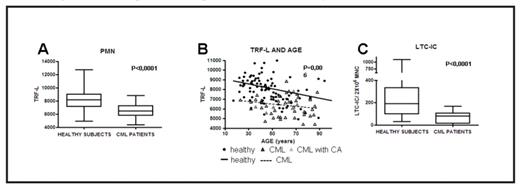Abstract
Background. Most chronic myelogenous leukemia (CML) patients (pts) restore non-neoplastic hematopoiesis following treatment with tyrosine kinase (TK) inhibitors. However little is presently known on the functional and genetic integrity of Ph-negative hematopoietic cells (HC) repopulating the bone marrow after successful treatment. Indeed, the frequent detection of cytogenetic abnormalities (CA) reminiscent of those seen in myelodysplastic syndromes suggests the potential presence of functional and genetic defects. These issues have been addressed using short and long term HC cultures and telomere restriction fragment length (TRF-L) analysis, which is considered a reliable marker of proliferative and oxidative damage.
Patients and methods. We investigated 71 CML pts in stable complete cytogenetic remission (CR) (CR had to be documented at least one year before the analysis). 62 pts were treated with Imatinib and 10 with α-interferon associated or not to ara-C. Median age was 64 (23–88), M/F ratio was 1.5, median time from diagnosis and from complete CR were 58 (7–915), and 40 months (12–150). 31 pts had low Sokal score, 27 intermediate, and 13 high. Complete and partial molecular responders were 35 and 21, respectively. 6 pts showed evidence of acquired CA in Ph-negative HC. TRF-L analysis was performed by Southern Blotting as previously described (Ladetto M et Al, Blood 2004), both on polymorphonucleates (PMN) and on monocyte-depleted PBMC (MD-PBMC) (as described by Rocci et al Exp Hematol 2007) to monitor both the myeloid and lymphoid compartment. Colony-forming unit granulocyte-macrophage (CFU-GM), burst-forming unit erythroid (BFU-E) and colony forming unit-mix (CFU-Mix) along with long-term culture-initiating cells (LTC-ICs) have been so far performed on 30 patients, using bone marrow mononuclear cells as previously described (Sutherland HJ et al Blood 1994). For both TRF-L and cell culture studies a control database of 86 healthy subjects has been used for comparison.
Results. PMN from CML patients showed a striking erosion of their telomeric DNA (figure 1A). Also MD-PBMC showed a degree of telomere shortening although the finding was much less pronounced (mean telomeric loss in PMN 1683 pb p<0.001; in MD-PBMC: 323 pb, p=0.04) We found no correlation between TRF-L and previously mentioned clinical parameters. Telomeric erosion is more severe in younger CML pts, resulting in loss of the association between TRF-L and age, typically seen in healthy subjects (figure 1B) Telomere shortening was observed regardless of the use of TK inhibitors. When a multivariate analysis on pts and healthy controls was performed, the presence of CML resulted a stronger predictor of telomeric damage compared to age. We found no correlation between TRF-L and previously mentioned clinical and demographic parameters. Telomeric erosion show no evidence of recovery on 40 follow-up samples taken after a median time of 10 months (range 6–13). Moreover, Ph-negative HC of CML pts were functionally impaired compared to controls with reduced numbers of CFU-Mix (median 2,62 vs 4, p=0,01), CFU-GM (median 99,5 vs 181, p<0,0001) and particularly of LTC-IC (median 88 vs 198, p<0,0001) (figure 1C).
Discussion. Ph-negative HC repopulating the bone marrow after successful CML treatment display severe telomeric DNA erosion, roughly comparable to 34 years of physiological aging. Moreover they display major defects in their functional performances. These findings, underline the need of additional investigation and careful clinical monitoring of the Ph-negative haemopoietic compartment in these subjects.
Disclosures: No relevant conflicts of interest to declare.
Author notes
Corresponding author


This feature is available to Subscribers Only
Sign In or Create an Account Close Modal